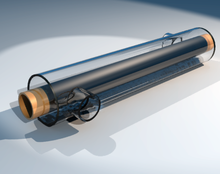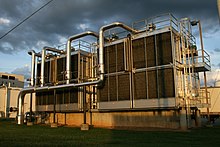Heat exchanger
A heat exchanger , also known as a heat exchanger or, more rarely, a heat exchanger , is a device that transfers thermal energy from one material flow to another.
Classification
Heat exchangers can be divided into three classes with regard to heat transfer :
- Direct heat transfer
- is based on the process of combined heat and mass transfer in separable material flows. A representative application is the wet cooling tower .
- Indirect heat transfer
- is characterized in that material flows are spatially separated by a heat-permeable wall. Heat exchangers of this class are also called recuperators . This class includes: B. Radiators.
- Semi-indirect heat transfer
- uses the properties of a heat storage system. Both substances are brought into contact with the heat accumulator with a time lag. The heat accumulator is alternately heated by the hotter medium and then cooled by the colder medium in order to transfer thermal energy from the hotter to the colder medium. Heat exchangers of this class are regenerators , e.g. B. the heat wheel .
The extent of the heat transfer depends heavily on the geometric guidance of the two material flows to one another. There are five basic forms to be distinguished here.
- Countercurrent
- guides the substances in such a way that they flow past each other in an oncoming direction. In the ideal case, the temperatures of the material flows are exchanged, which means that the originally cold medium reaches the temperature of the originally hot medium and vice versa. The prerequisites for this ideal case are the same heat capacity flows on both sides of the heat exchanger and an efficiency = 1 of the heat exchanger. Therefore, in practice, it is not possible to completely swap temperatures. One application is heat recovery .
- Direct current
- guides the fabrics side by side in the same direction. Ideally, both material temperatures are equalized and always lie between the initial temperatures. The direct current is used, for example, if fast, reliable cooling is necessary. The material stress caused by the temperature differences can be a disadvantage.
- Cross flow
- guides the material flows in such a way that their directions cross each other. The result is somewhere between countercurrent and direct current. The cross flow is used, for example, to bring one flow to a certain, fixed temperature.
- Eddy current
- swirls two different hot material flows. A possibility for subsequent separation is necessary. One possibility for this is the vortex tube , a device without moving parts that can be used to split gas into a hot and a cold stream.
Combinations of these basic shapes are also used, as their advantages complement each other.
- Cross countercurrent
- allows the fabrics to flow partially across and partially parallel to each other. In the ideal case, the temperatures of the material flows are exchanged as in the case of counterflow. A cross-countercurrent heat exchanger is often easier to manufacture, more streamlined and more compact than a pure countercurrent heat exchanger.
execution
General
For good efficiency, the component that separates the media must have good thermal conductivity and a large surface. A turbulent flow is beneficial for good heat transfer . This takes place above all with a high Reynolds number . Therefore the flow rate should be high and the viscosity of the media low. However, high speed and a large wetted surface also require a high expenditure of energy to pump the media through the heat exchanger.
In heat exchangers in which one medium is a liquid and the other medium is a gas (mostly air), the heat capacities differ greatly depending on the volume of the media. Much more gas than liquid has to flow through, and the area for heat transfer has to be increased on the gas side. This is often done by means of ribs or sheets, e.g. B. in high-temperature radiators, the cooling coils on the back of a refrigerator or air conditioning and the radiator of the car.
materials

In most cases, heat exchangers are made of metal , but also of enamel , plastic , glass or silicon carbide . In the air conditioning sector, copper and aluminum are predominantly used because of their good thermal conductivity . In industrial plants, steel , especially stainless steel , is mainly used because of its durability . Radiators, on the other hand, are now mostly made of sheet steel , previously made of gray cast iron .
Plastic , enamelled steel , technical glass or silicon carbide are used for heat exchangers in the chemical industry when the aggressiveness of the fluids does not allow the use of metallic materials. Due to its extreme temperature resistance (decomposition temperature above 2200 ° C), silicon carbide can also be used in heat exchangers whose material temperatures are above the application limit of the metals. Such ceramic high-temperature heat exchangers are, however, still under development.
Designs
Only the types of heat exchangers for liquid and gaseous media are dealt with here:
Heat exchanger for direct heat transfer
- Wet cooling towers are used for re-cooling tasks in power plants. Warm water is cooled in direct contact with the ambient air.
Recuperators
Recuperators each have a separate room for the two media.
-
Plate heat exchanger : Numerous parallel plates, the gaps are alternately occupied by one and the other medium.
- Spiral heat exchanger as a special form of plate heat exchanger in which instead of flat plates, a sheet metal wound in a spiral shape is used.
-
Tube heat exchanger or tube bundle heat exchanger : A medium is pumped or conveyed in some other way through the tubes ("tube space"; usually a large number of parallel tubes). The pipes are located in the so-called shell space, a larger pipe or boiler through which another medium flows.
- U-tube heat exchanger in which the tubes are bent into a U-shape. The advantage is that the tube bundle can be inserted and removed more easily from the boiler because it is only attached on one side (e.g. welded into the lid of the boiler).
- Heat pipes are closed at both ends and contain a medium for heat transfer, which automatically circulates within the closed pipe through continuous condensation and re-evaporation.
- Jacketed heat exchangers consist of two concentric tubes; the medium in the inner pipe is heated or cooled by the medium in the outer pipe (usually water). This design is used for highly viscous or solids-laden media (e.g. suspensions, slurries), but has a low heat transfer surface and thus a low level of efficiency. It is particularly suitable for high pressures in the inner pipe.
-
Heating registers or cooling registers are a combination of pipes (for the liquid medium) and fins attached to them (for the gaseous medium).
- A countercurrent layer heat exchanger is composed of two or more lamellar heat exchanger layers (heating or cooling registers).
Regenerators
The storable base of regenerators is alternately flowed through by the hot and cold medium. The length of the interval between the reversal of the direction of flow depends on the mass flow of the medium and the heat capacity of the storage mass.
-
Regenerators are mainly used for gases; the thermal energy is temporarily stored in a solid and later released from the same surface to the other air flow. One distinguishes
- Movable storage masses as in the rotary heat exchanger (air preheater) and Stirling engine .
- Fixed storage masses such as industrial wind heaters or small ventilation devices with alternating air flow through reversing fans that are used for decentralized ventilation of individual rooms.
In rotary heat storage z. B. aluminum sheets, copper braids for regenerators in Stirling engines and refractory bricks or ceramic storage masses for wind heaters.
Calculation and evaluation of recuperators
Ideal energy balance
In its basic function, a heat exchanger has two fluids flowing through it in order to bring them to predetermined thermodynamic states. The thermal power emitted by the hot current (index: H) and simultaneously consumed by the cold current (K) is determined using the following energy balance :
The power , depending on the mass flow , the specific heat capacity and the temperature difference between the inlet (index: E) and the outlet (A), corresponds to the energy transported between the two fluids due to heat :
Here is the heat transfer coefficient , the heat transfer area and the (effective) mean temperature difference. The mean temperature difference is in turn dependent on the two inlet temperatures, the transmitted power, and in particular on the flow of both fluids through the apparatus, such as. B. a parallel flow, or cross flow. Linking the balances of the power and dividing by the maximum possible temperature difference between the two inlet temperatures continues to deliver
as a dimensionless transport equation.
Dimensionless key figures
The dimensionless transport equation provides the following heat exchanger parameters:
- Dimensionless performance or operating characteristics:
The key figure indicates the actual performance in relation to the theoretical limit performance (due to the temperature compensation ) of a counterflow heat exchanger. It is therefore a dimensionless quantity with a numerical value between and . The operating characteristic can also be interpreted as a thermal efficiency due to the power ratio.
- Dimensionless heating surface, depending on the theory and application also referred to as the number of transfer units or as the NTU value:
The operating characteristics can be shown in a diagram as the ordinate over the dimensionless quantity as the abscissa (with the ratio of the heat capacity flows). With an increasing dimensionless heating surface (construction costs due to the surface), the dimensionless output also increases, until the theoretical limit output is reached in the limit case of an infinite heat transfer surface .
- Dimensionless mean temperature difference:
The working points of a heat exchanger are in the - diagram on a straight line through the origin with the slope .
- Ratio of the heat capacity flows:
This variable finally characterizes the task of the heat exchanger. It is used to convert the quantities for hot and cold electricity.
Ideal flow guidance
Co-current and counter-current
There are a number of methods for calculating heat exchangers, which differ in terms of computational effort and accuracy. To determine the thermal output, it is usually sufficient to use a mean temperature difference of the entire apparatus that is dependent on the flow control. Heat exchangers with parallel flow guidance are often used in practice. Depending on whether the two material flows move in the same or opposite direction, the following applies:
- Direct current:
- Countercurrent:
The mean temperature difference with parallel current can also be indicated by the logarithmic mean value (the derivation follows from the relationship if the temperatures are used for the key figures):
The mean value lies between the temperature differences of the media on both sides of the heat exchanger. In the case of cocurrent these are the temperature differences on the inlet side and on the outlet side and in the case of countercurrent these are the temperature differences between the inlet of one medium and the outlet of the other medium.
Cross flow
Another idealized flow guidance in tube bundle or plate heat exchangers is the cross flow. In the pure cross flow, the two material flows run perpendicular to one another and are not cross-mixed in the direction of flow, compared to the parallel flow.
- Pure cross flow (without cross mixing):
Here is the faculty of . At given inlet and outlet temperatures on the apparatus side, the countercurrent requires the smallest heat transfer surface, while the direct current represents a very unfavorable current flow in terms of thermal output. With regard to the mean temperature difference, the pure cross flow lies between the values for the counterflow and cocurrent apparatus. Other types of flow:
- Cross flow, cross-mixed on one side:
- Cross flow, cross-mixed on both sides:
Cross countercurrent
In addition to the pure form, the cross flow also occurs in connection with parallel flow. Such a circuit is obtained z. B. by combining several plate elements on top of each other. The flow continues to flow through each element, but the main movement of the flows takes place above the height due to repeated diversions. In the case of an opposite flow, there is a countercurrent again in this sense. The mean temperature difference of such a cross-countercurrent circuit is between the values for the countercurrent and the pure crosscurrent.
- Cross countercurrent (without cross mixing):
Each of the areas continues to be purely cross-flow. In cross-flow heat exchangers with several passages, the thermal output depends on the flow of the two fluids over the entire apparatus (main flow direction) and, if applicable, on the degree of cross-mixing within each passage and the areas in between. This creates further variants of the most varied of circuits of multi-pass cross-flow heat exchangers.
- Cross countercurrent, cross-mixed on one side:
Such a circuit is obtained, for example, with tube bundle heat exchangers.
- Multi-pass cross-flow heat exchangers:
Such a circuit is obtained, for example, in multi-course plate heat exchangers.
Heat transfer with phase transition
With a phase change of a pure fluid (single-component system) in a heat exchanger, the temperature of the fluid in question remains constant. The following applies to the operating characteristics:
The specified value applies to both the evaporation and condensation process .
Applications
Both media in gaseous form
- Use of exhaust gas heat to preheat the intake combustion air in industrial systems, e.g. B. Rotary heat exchangers and wind heaters .
- Use of exhaust air heat for heat recovery , i.e. heating of the supply air when ventilating air-conditioned buildings or for passive houses , so-called air-to-air heat exchangers.
- Air / air heat exchanger for control cabinet cooling .
- Charge air cooler for internal combustion engines
One medium is gaseous, one is liquid
- Air heating or cooling for direct thermal treatment of the supply air in air conditioning systems
- Room air heating via radiators as a convector : The ribbed design is characteristic, which allows large surfaces to be achieved.
- Regenerative heat recovery for heating or cooling the supply air in air-conditioned buildings.
- Feed water preheating of steam boilers (" economiser ").
- Air / water heat exchanger for control cabinet cooling .
- Heat transfer for hot water production in gas boilers .
- Charge air cooler for combustion engines with indirect charge air cooling
One medium gaseous, one in the phase transition gaseous / liquid
- Condensation in steam turbines.
- Evaporation in steam boilers in coal-fired power plants and steam generators in nuclear power plants.
- Evaporation and condensation of the refrigerant in air conditioning systems .
- Heat transfer from air to the refrigerant in the evaporator of heat pumps for heating buildings.
- Heat dissipation via cooling coil in and on the rear wall of refrigerators .
- Heat pipe
- Heat transfer in condensation tumble dryers (without exhaust air connection).
One medium liquid, one in the phase transition gaseous / liquid
- Condenser for heat pumps in heating systems
Both media are liquid
- Groundwater heat transfer for heat pumps .
- Heat transfer in ocean-thermal gradient power plants (" ocean heat power plant ").
- Heat transfer in storage boilers from thermal solar systems .
- Heat transfer in a fresh water station .
- Heat transfer between seawater and cooling water from marine diesel engines .
- Heat transfer in district heating networks
- From biology: In order to minimize heat loss when touching the cold ground, the veins run in penguin feet like in a countercurrent heat exchanger.
Other
The following applications are actually not part of the heat exchangers, since the heat is not transferred between two flowing media: geothermal heat exchanger , half-pipe coil , heat sink , radiator .
See also
literature
- H. Schnell: Heat exchangers, energy saving through optimization of heating processes . 2nd Edition. Vulkan-Verlag, Essen 1994, ISBN 3-8027-2369-4 .
- Herbert Jüttemann: Heat and cold recovery . 4th edition. Werner Verlag, Düsseldorf 2001, ISBN 3-8041-2233-7 .
- Eberhard Wegener: Planning a heat exchanger: holistic solution to the repair of a tube bundle heat exchanger . 1st edition. Wiley-VCH Verlag, Weinheim 2013, ISBN 978-3-527-33304-2 .
- Hartmut Kainer: Ceramic heat exchangers . In: Yearbook Technical Ceramics . 1st edition. Vulkan-Verlag, Essen 1988, p. 338-344 .
Web links
Individual evidence
- ↑ Hartmut Kainer et al.: Ceramic recuperators for high temperature processes. Final report on the BMFT research project 03E-8658 A, Didier Werke AG. Self-published, Wiesbaden, April 1991.
- ↑ a b c d e f g Association of German Engineers, VDI Society Author: VDI-Wärmeatlas . Springer-Verlag, 2013, ISBN 978-3-662-10743-0 .
- ↑ a b c d T. Möller, O Strelow: A matrix calculation model for the simulation and quick calculation of the mean temperature difference of multiple-pass cross-flow plate heat exchangers. In: Research in Engineering. Vol 81, Issue 4, 2017, pp. 357-369.
- ^ E. Doering, H. Schedwill, M. Dehle: Fundamentals of technical thermodynamics. 6th edition. Vieweg + Teubner Verlag, Wiesbaden 2008, p. 328.
- ^ T. Möller: Modeling and simulation of block-type multi-pass plate heat exchangers. 49th Power Plant Technology Colloquium, Oct 2017.
- ^ A b E. Doering, H. Schedwill, M. Dehle: Fundamentals of technical thermodynamics. 6th edition. Vieweg + Teubner Verlag, Wiesbaden 2008, pp. 330–333.
- ^ W. Nusselt: A new formula for the heat transfer in the cross flow. In: Technical Mechanics and Thermodynamics. Vol 1, Issue 12, 1930, pp. 417-422.
- ^ H. Hausen: Heat transfer in countercurrent, cocurrent and crosscurrent. 2nd Edition. Springer Verlag, 1976.
- ^ E. Doering, H. Schedwill, M. Dehle: Fundamentals of technical thermodynamics. 6th edition. Vieweg + Teubner Verlag, Wiesbaden 2008, p. 337.













































